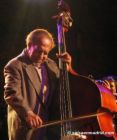 Just shy of 23 years ago, when I shared a tiny apartment in D.C. with two music-obsessed buddies, a staggering collection of vinyl, and zero umbrellas, I walked a few miles in an insane rainstorm wearing a garbage bag to see the Feelies play the 9:30 Club, and it was worth every soggy step. On another grey day a month ago, I traveled 3000 miles on a redeye in time to see the Feelies play again in the 9:30 Club (now no longer at 930 F Street, but with more space, better ventilation and non-poisonous drinks). One of the least prolific great bands ever and one of the few that roll as much as they rock, the Feelies played as if they’d never skipped a single kinetic beat during their 17-year hiatus. Once the hyperactive teenage pride of Haledon, New Jersey, they’re holding their own as the quadragenarians with perpetual nervousness. “Reunion” doesn’t quite do justice to their recent shows, which come off more like an alternate history of popular music, as it might have sounded if smart people had ruled the world.
Just shy of 23 years ago, when I shared a tiny apartment in D.C. with two music-obsessed buddies, a staggering collection of vinyl, and zero umbrellas, I walked a few miles in an insane rainstorm wearing a garbage bag to see the Feelies play the 9:30 Club, and it was worth every soggy step. On another grey day a month ago, I traveled 3000 miles on a redeye in time to see the Feelies play again in the 9:30 Club (now no longer at 930 F Street, but with more space, better ventilation and non-poisonous drinks). One of the least prolific great bands ever and one of the few that roll as much as they rock, the Feelies played as if they’d never skipped a single kinetic beat during their 17-year hiatus. Once the hyperactive teenage pride of Haledon, New Jersey, they’re holding their own as the quadragenarians with perpetual nervousness. “Reunion” doesn’t quite do justice to their recent shows, which come off more like an alternate history of popular music, as it might have sounded if smart people had ruled the world.
 As a longtime fan who witnessed the show astutely observed, the Feelies played as if they were holding a clinic on how to be a rock band. This wouldn’t be their first academic adventure. Long ago, billed as the Willies (one of several alternate monikers used by their shifting alliances, along with the Trypes and Yung Wu), they played the high school reunion scene in Jonathan Demme’s Something Wild. If the Ramones were lifers in rock and roll high school, the Feelies are custom-built for graduate school, from their Aldous Huxley-inspired band name to their role in inspiring Rick Moody’s novel Garden State (not to be confused with the Zach Braff movie/ Shins vehicle).
As a longtime fan who witnessed the show astutely observed, the Feelies played as if they were holding a clinic on how to be a rock band. This wouldn’t be their first academic adventure. Long ago, billed as the Willies (one of several alternate monikers used by their shifting alliances, along with the Trypes and Yung Wu), they played the high school reunion scene in Jonathan Demme’s Something Wild. If the Ramones were lifers in rock and roll high school, the Feelies are custom-built for graduate school, from their Aldous Huxley-inspired band name to their role in inspiring Rick Moody’s novel Garden State (not to be confused with the Zach Braff movie/ Shins vehicle).
If that pedigree sounds a shade uppity, rest assured that Feelies University is a place with little pretension and truckloads of rock and roll fun. Here’s a sample curriculum:
• Velvet Revolver (Professors Mercer and Million)
No, not that Velvet Revolver. In this class, the affably mysterious guitarist/ singer Glenn Mercer and perpetually grumpy rhythm guitarist Bill Million demonstrate how to mesh the shimmering legacies of the late Velvet Underground and the Beatles’ Revolver. While some contemporary lessons come from Mercer’s solo 2007 return to form, Wheels in Motion, this could not be a Feelies course without the participation of Million, newly returned from his lengthy, self-imposed Florida exile.
• More Cowbell (Professor Weckerman)
Feelies percussionist Dave Weckerman (not the drummer, the percussionist) shows how just the right amount of cowbell—or woodblock, or maracas, or triangle, or virtually anything you can bang—helps turn a song into an adventure.
• Crazy Rhythms (Professors Demeski and Sauter)
Rhythm masters Stanley Demeski and Brenda Sauter weren’t yet in the Feelies for their exhilarating and hard-to-find debut Crazy Rhythms, which featured Keith DiNunzio on bass and drummer Anton “Andy” Fier before he went downtown to work with the Lounge Lizards and Golden Palominos. But they’ve mastered the art, and were the anchors of the Feelies’ three remaining albums. While neither is flashy, together they create an unshakable pulse.
• Advanced Band Dynamics (Full Faculty)
There’s a time and place for bone-crunching 4/4 rhythms, but that’s in Professor Young’s AC/DC seminar. If you want a song to whisper and twist and turn and howl and pounce, slip into something like the Feelies’ “Slippping (Into Something).â€
• Undercover Studies (Full Faculty)
Learn to cover the Velvets (“What Goes On,” “Real Good Time”), the Beatles (“She Said She Said”), Neil Young (“Barstool Blues”), the Modern Lovers (“I Wanna Sleep in Your Arms”), and Patti Smith (“Dancing Barefoot”) in a single show and add something fresh to each of them. Surprise final exam: cover “Boxcars (Carnival of Sorts)†from REM’s debut Chronic Town, which way back then came off like a rural southern take on the Feelies–that is, before the Feelies raised the ante with their own pastoral soundscape, The Good Earth.
The Feelies are reportedly working on long-anticipated reissues of Crazy Rhythms and The Good Earth. In the meantime, crawl through locusts, pestilence or whatever else stands in your path to see them if you get the chance.
Feelies, “The Boy with Perpetual Nervousness” (instrumental version)
Feelies, “Higher Ground”
Feelies, “Dancing Barefoot”
Feelies, “Crazy Rhythm”



